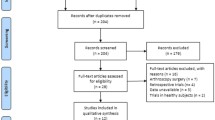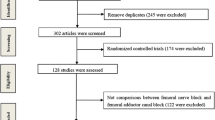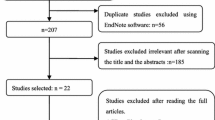Abstract
Purpose
The methods for pain control after total knee arthroplasty (TKA) vary and have been extensively studied in recent years. Femoral nerve block (FNB) is used as the standard method due to its effective pain control following TKA, but it may weaken the quadriceps strength. Adductor canal block (ACB) is a newly developing analgesic protocol with fast functional recovery and good pain control after TKA. A meta-analysis was conducted to try to find out if ACB is better than FNB in pain treatment and joint functional recovery after TKA.
Methods
The databases PubMed, Web of Science, Embase, and Cochrane Library were systematically searched. Of 66 records identified, eight randomised controlled trials (RCT) involving 434 patients (504 knees) were eligible for data extraction and meta-analysis according to criteria included.
Results
Meta-analysis showed that ACB can significantly decrease visual analogue scale (VAS) score at rest within eight hours (p < 0.001) and at 24 hours (p < 0.001) after operation compared to FNB after TKA, and improve quadriceps strength (p < 0.001) and mobilization ability (p < 0.001). However, the differences in VAS score at rest at 48 hours, VAS score with activity within two days after operation, opioid consumption, hip adductor strength, patient satisfaction, and tourniquet times were not significant between the two groups.
Conclusion
ACB provide better ambulation ability, faster functional recovery and better pain control at rest after TKA compared to FNB. The use of ACB post TKA is worthy of being recommended to replace FNB as a standard analgesic protocol for pain treatment after TKA.







Similar content being viewed by others
References
Yang Z, Liu H, Xie X, Kang P et al (2014) The influence of diabetes mellitus on the post-operative outcome of elective primary total knee replacement: a systematic review and meta-analysis. Bone Joint J 96:1637–1643
Xie X, Pei F, Huang Z, Tan Z, Yang Z, Kang P (2015) Does patellar denervation reduce post-operative anterior knee pain after total knee arthroplasty? Knee Surg Sports Traumatol Arthrosc 23:1808–1815
Paul JE, Arya A, Hurlburt L, Cheng J (2010) Femoral nerve block improves analgesia outcomes after total knee arthroplasty: a meta-analysis of randomized controlled trials. Anesthesiology 113:1144–1162
Atkinson HD, Hamid I, Gupte CM (2008) Post-operative fall after the use of the 3-in-1 femoral nerve block for knee surgery: a report of four cases. J Orthop Surg (Hong Kong) 16:381–384
Andersen HL, Zaric D (2014) Adductor canal block or midthigh saphenous nerve block same but different name! Reg Anesth Pain Med 39:256–257
Jin SQ, Ding XB, Tong Y (2015) Effect of saphenous nerve block for post-operative pain on knee surgery: a meta-analysis. Int J Clin Exp Med 8:368–376
Hanson NA, Allen CJ, Hostetter LS, Nagy R (2014) Continuous ultrasound-guided adductor canal block for total knee arthroplasty: a randomized, double-blind trial. Anesth Analg 118:1370–1377
Jæger P, Koscielniak-Nielsen ZJ, Schrøder HM (2014) Adductor canal block for post-operative pain treatment after revision knee arthroplasty: a blinded, randomized, placebo-controlled study. PLoS One 9:e111951
Oremus M, Wolfson C, Perrault A, Demers L, Momoli F, Moride Y (2001) Interrater reliability of the modified Jadad quality scale for systematic reviews of Alzheimer’s disease drug trials. Dement Geriatr Cogn Disord 12:232–236
Rasmussen M, Kim E, Kim T et al (2015) A retrospective comparative provider workload analysis for femoral nerve and adductor canal catheters following knee arthroplasty. J Anesth 29:303–307
Patterson ME, Bland KS, Thomas LC et al (2015) The adductor canal block provides effective analgesia similar to a femoral nerve block in patients undergoing total knee arthroplasty--a retrospective study. J Clin Anesth 27:39–44
Mudumbai SC, Kim TE, Howard SK et al (2014) Continuous adductor canal blocks are superior to continuous femoral nerve blocks in promoting early ambulation after TKA. Clin Orthop Relat Res 472:1377–1383
Grevstad U, Mathiesen O, Valentiner LS, Jaeger P, Hilsted KL, Dahl JB (2015) Effect of adductor canal block versus femoral nerve block on quadriceps strength, mobilization, and pain after total knee arthroplasty: a randomized, blinded study. Reg Anesth Pain Med 40:3–10
Memtsoudis SG, Yoo D, Stundner O, Danninger T et al (2015) Subsartorial adductor canal vs femoral nerve block for analgesia after total knee replacement. Int Orthop 39:673–680
Kim DH, Lin Y, Goytizolo EA, Kahn RL et al (2014) Adductor canal block versus femoral nerve block for total knee arthroplasty: a prospective, randomized, controlled trial. Anesthesiology 120:540–550
Shah NA, Jain NP (2014) Is continuous adductor canal block better than continuous femoral nerve block after total knee arthroplasty? Effect on ambulation ability, early functional recovery and pain control: a randomized controlled trial. J Arthroplast 29:2224–2229
Zhang W, Hu Y, Tao Y et al (2014) Ultrasound-guided continuous adductor canal block for analgesia after total knee replacement. Chin Med J (Engl) 127:4077–4081
Jæger P, Zaric D, Fomsgaard JS et al (2013) Adductor canal block versus femoral nerve block for analgesia after total knee arthroplasty: a randomized, double-blind study. Reg Anesth Pain Med 38:526–532
Kwofie MK, Shastri UD, Gadsden JC et al (2013) The effects of ultrasound-guided adductor canal block versus femoral nerve block on quadriceps strength and fall risk: a blinded, randomized trial of volunteers. Reg Anesth Pain Med 38:321–325
Jaeger P, Nielsen ZJ, Henningsen MH et al (2013) Adductor canal block versus femoral nerve block and quadriceps strength a randomized, double-blind, placebo-controlled, crossover study in healthy volunteers. Anesthesiology 118:409–415
Lund J, Jenstrup MT, Jaeger P, Sørensen AM, Dahl JB (2011) Continuous adductor-canal-blockade for adjuvant post-operative analgesia after major knee surgery: preliminary results. Acta Anaesthesiol Scand 55:14–19
Ilfeld BM, Duke KB, Donohue MC (2010) The association between lower extremity continuous peripheral nerve blocks and patient falls after knee and hip arthroplasty. Anesth Analg 111:1552–1554
Hozo SP, Djulbegovic B, Hozo I (2005) Estimating the mean and variance from the median, range, and the size of a sample. BMC Med Res Methodol 5:13
Jenstrup MT, Jæger P, Lund J et al (2012) Effects of adductor-canal-blockade on pain and ambulation after total knee arthroplasty: a randomized study. Acta Anaesthesiol Scand 56:357–364
Perlas A, Kirkham KR, Billing R et al (2013) The impact of analgesic modality on early ambulation following total knee arthroplasty. Reg Anesth Pain Med 38:334–9
Lund J, Jenstrup MT, Jaeger P, Sorensen AM, Dahl JB (2011) Continuous adductor-canal-blockade for adjuvant post-operative analgesia after major knee surgery: preliminary results. Acta Anaesthesiol Scand 55:14–19
Campbell A, McCormick M, McKinlay K et al (2008) Epidural vs. lumbar plexus infusions following total knee arthroplasty: randomized controlled trial. Eur J Anaesthesiol 25:502
Fowler SJ, Symons J, Sabato S et al (2008) Epidural analgesia compared with peripheral nerve blockade after major knee surgery: a systematic review and meta-analysis of randomized trials. Br J Anaesth 100:154
Author information
Authors and Affiliations
Corresponding author
Additional information
Donghai Li and Zhouyuan Yang contributed equally to this work.
Rights and permissions
About this article
Cite this article
Li, D., Yang, Z., Xie, X. et al. Adductor canal block provides better performance after total knee arthroplasty compared with femoral nerve block: a systematic review and meta-analysis. International Orthopaedics (SICOT) 40, 925–933 (2016). https://doi.org/10.1007/s00264-015-2998-x
Received:
Accepted:
Published:
Issue Date:
DOI: https://doi.org/10.1007/s00264-015-2998-x




